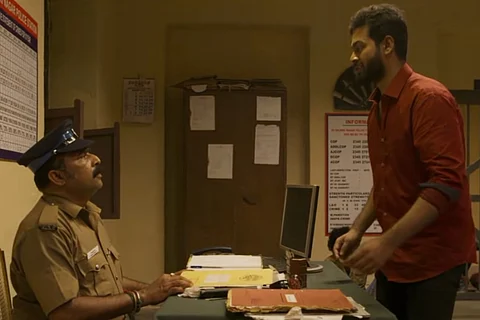

The first thing one would notice about the 2022 Tamil film Yuddha Kaandam is that it is a single-shot film. With an elaborate tracking shot of a police vehicle that the film opens, lasting for a good minute, the makers ensure that we notice this about the movie. The makers of Yuddha Kaandam have also promoted it as the ‘first proper commercial single-shot film’. But we shall get back to this in a bit.
Yuddha Kaandam is ridden with so many cliches that it can seem like a tutorial video for making a quintessential mainstream Tamil action film. It has a protagonist who goes to great lengths to save his romantic partner. The antagonist is a police officer who has everything it takes to be the archetypical Kollywood villain. He smokes, abuses, and sexually harasses women. We know he is a ‘Kettavan’ (bad guy) but we don’t know why he is one. For every bad character, there is a good one like the other police officers in the station who secretly help the couple.
The film, which was screened at this year’s Chennai International Film Festival, tracks the events that transpire at a police station after the protagonist Ramalingam (Sriram Karthick) arrives at the Valmiki Nagar police station to file a complaint about his partner Mithila (Krisha Kurup) who went missing, thus paving the way for a series of twists and turns that were intended to pack hefty punches, but fall flat.
Yudha Kaandam follows the format of many recently released Tamil films such as Parthiban’s Iravin Nizhal, which is reportedly the world’s first single-shot, non-linear film, and director Aju Kizhumala’s one-shot film Drama, which was also based on the events that happen in a police station overnight when the power goes off and a murder occurs.
In several scenes, the acting by the cast of Yudha Kaandam appears overtly staged. This, coupled with poor writing, makes it hard for one to stay invested in the film. Although understandably, acting in a single-shot film is not an easy task, filmmakers must question whether actors performing at a stretch truly makes a considerable difference to the narrative they build.
It should not come as a surprise that a lot of scenes in the film are predictable. Director Anantharajan hops from one conflict to another, without giving enough time for it to seep in. The viewers often get little context to resonate with the plot. The title Yuddha Kaandam seems to be inspired by the chapter Yuddha Kaanda in the Hindu epic Ramayana which is based on the fight between Ram and Ravana. However, Anantharajan fails to make the conflict between the protagonist and the ‘villain’ believable in the film.
Remaining faithful to the vision — which was perhaps recreating a Tamil film from the 90s — director Anantharajan uses background score to painfully exaggerate the emotions he wants to bring out. What he fails to understand is that replaying an over-the-top background score to keep audiences hooked backfires when the same track is played repeatedly throughout its run time. The untimely placement of a romantic track at a pivotal point in the movie prompted audiences in the theatre to erupt into laughter instead of celebrating the couple’s (Ramalingam and Mithila’s) reunion.
Falling in line with depictions by other Kollywood filmmakers and their limitless obsession with violence, Anantharajan felt the need to visualise all the gory details on the screen, which is discomforting. This is exemplified through scenes where the victim is covered in a pool of blood, and when the camera pans over the body of a survivor of sexual harassment, further dehumanising them.
Like the Parthiban directorial Iravin Nizhal, Yuddha Kaandam is accompanied by a lengthy making video. With a team of twenty-five actors, hundred technicians, and fifty rehearsals, the film was painstakingly filmed during the COVID-induced lockdown, or so we are told by the makers.
It is to be noted that the phenomenon of single-shot movies is not exactly new to Indian cinema, with examples dating back to 2011 (Six Hours with Terrorists) and even recent ones like the 2021 film Man Naked helmed by Sanjeev Kaul. No doubt, making a single-shot film requires strategic, logistical, and technical prowess but it brings me back to my initial point about single-shot movies and how filmmakers should perhaps rethink why in recent films like Iravin Nizhal and Yuddha Kaandam the spotlight has been on the marketing of single-shot cinema and not on how filming a movie in one go adds to the plot.
When Russian Ark, the story about a French marquess taking a Persian ambassador on a museum tour was taken as a single-shot movie, filmmaker Alexander Sokurov was praised for effectively combining elements of theatre with that of cinema. By placing a camera at the centre of a car and filming the 85-minute-long film Santhoshathinte Onnam Rahasyam from a neutral perspective, director Don Palathara could give room for the audience’s gaze to be truly unbiased while viewing the lead characters - a couple who are on the way to the hospital to find out if they are pregnant. Perhaps the makers of Yuddha Kaandam too should have explored how the method of single-shot filming would enhance their vision.
Watch the trailer of ‘Yuddha Kaandam’ here: